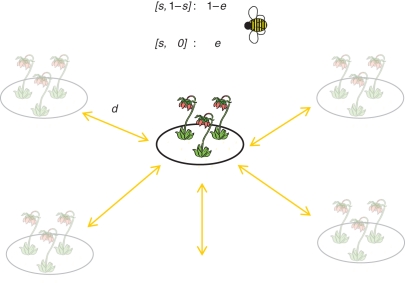Fig. 2.
Joint evolution of dispersal and self-fertilization in a temporally heterogeneous pollination environment (from Cheptou and Massol, 2009; Massol and Cheptou, 2011). The model assumes an infinite island model where each patch is prone to temporally heterogeneous pollination because of the stochastic presence of pollinator (see Kalisz et al., 2004, for empirical support). We consider a basic mechanism of self-fertilization: plants self-fertilize a proportion, s, of their ovules while the proportion 1 – s can be fertilized by outcrossing only if pollinators are present, which occur with a probability (1 – e). Otherwise, the fraction 1 – s is left unfertilized (probability e). Seeds produced disperse at random among patch at rate d but only a fraction q survive to dispersal. Progeny produced by self-fertilization suffer from inbreeding depression (δ). Model outcome: the mathematical analysis (invasion analysis) reveals that only two syndromes of traits are possible: the ‘dispersal/outcrossing’ syndrome (d* = (e/[1 – q(1 – e)], s* = 0) and the ‘no-dispersal/selfing’ syndrome (d* = 0, s* = (2e/[2δ + e – 1])) (see Cheptou and Massol, 2009, for the influence of parameters). Pollination fluctuations suffered by out-crossers create among-patch variance and thus favour dispersal (see Comins et al., 1982). In contrast, selfers do not suffer from pollination heterogeneity, thus cancelling selection pressure for dispersal.

